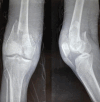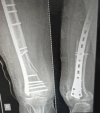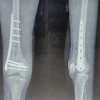Role of Distal Femur Anatomical Plate in Fracture of Distal Femur
- PMID: 40635941
- PMCID: PMC12237481
- DOI: 10.13107/jocr.2025.v15.i07.5834
Role of Distal Femur Anatomical Plate in Fracture of Distal Femur
Abstract
Introduction: Distal femur fractures are mostly caused due to vehicular injuries in the middle-aged population. Operative treatment has been preferred with open reduction and internal fixation in these fractures. Due to the availability of anatomical locking compression plates (LCPs), better results and improved functional outcomes have been observed. This study aims to observe the surgical outcome of distal femur fractures operated with an anatomical LCP.
Materials and methods: A prospective study was carried upon 48 patients with 40 male and 8 female patients having fractures of the distal femur. The mean age of presentation was 40.6 years. Thirty of them had vehicular injuries and 18 had a history of fall. Open fractures were seen in 22 patients and associated ipsilateral limb injuries were seen in 16 and contralateral limb injuries were seen in 8 patients. The patients were treated with anatomical LCP. The lateral approach was used in all cases for my study.
Results: The mean follow-up in the present study was 6 months. All fractures were united with a mean union period of 18.2 weeks. At final follow-up, fixed flexion deformity was seen in 25% of the patients. There were 16 cases of infection with 2 being a superficial infection treated conservatively and 14 cases having a deep infection treated with debridement and antibiotics. 2 cases of nonunion, 4 cases of malunion and 4 cases of delayed union were observed. 16 cases develop joint stiffness. 16 cases also developed limb shortening and 10 had fixed flexion deformity and 8 had varus deformity. At the time of final follow-up through "SCHATZKER AND LAMBERT SCORING SYSTEM," satisfactory outcomes were achieved in 50% (20.8%excellent and 29.2% good) of the patients.
Conclusion: Distal femur fracture treated with anatomical LCP needs careful anatomical reduction, rigid fixation and early knee mobilisation and weight bearing on signs of healing with an early presentation to the hospital from the time of injury were the essential factors in achieving better outcome for the patient.
Keywords: Distal femur anatomical plate; Schatzker and Lambert scoring system; distal femur fracture.
Copyright: © Indian Orthopaedic Research Group.
Conflict of interest statement
Conflict of Interest: Nil
Figures





References
-
- Martinet O, Cordey J, Harder Y, Maier A, Buhler M, Barraud GE. The epidemiology of fractures of the distal femur. Injury. 2000;31(Suppl 3):C62–3. - PubMed
-
- Crist BD, Rocca GJ, Murtha YM. Treatment of acute distal femur fractures. Orthopaedics. 2008;31:681–90. - PubMed
-
- Colling C, Wiss D. Rockwood and Green's Fracture in Adults. 7th ed. Vol. 2. United States: Lippincott Williams and Wilkins;???; pp. 1719–51.
-
- Court-Brown CM, Caesar B. Epidemiology of adult fractures:A review. Injury. 2006;37:691–7. - PubMed
-
- Ahmad M, Nanda R, Bajwa AS, Candal-Couto J, Green S, Hui AC. Biomechanical testing of locking compression plates:Is distance between bone and implant significant? J Bone Joint Surg ??? 88-B:401. - PubMed
LinkOut - more resources
Full Text Sources
